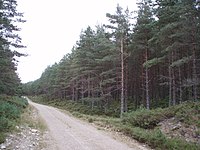JA:Key:taxon
 |
| 説明 |
|---|
| 地物の分類群を記述します。 |
| グループ: 自然 |
| 適用できる要素 |
| よく併用されるタグ |
| 状態:使用中 |
| ツール |

taxon=Lychnis flos-cuculi taxon:en=Ragged Robin定義
樹木や植物の生物学上の![]() タクソンを示すため、
タクソンを示すため、natural=wood natural=tree barrier=hedge や landuse=forest や natural=scrub natural=marsh natural=heath と関連付けて、または個別に使います。
taxon を使用することで、すべてのマッパーが有能な植物学者でなくても、マッピングされた地物の生物学的な構成の記述が様々なタグ(例えば name:biological=* genus=* species=*)に拡散し、一貫性がなくなること(例えば、 species=Oak)を防ぐことができます。また、 taxonomy:taxon_level のようなタグを使えば、生物学事典の分類学的なタグ付け方法と意味的に同じにすることができます。
生物学の純正主義者が期待する(例えば、ピンク色の花の変種を Robinia sp. とする)よりは緩く使うことを意図しています。これは、知識、場所、時期、その他の要因により、正確に植物を識別することがおそらくできないからです。興味のある外来種の木がある場所は、専門家であってもたやすく識別できないでしょうが、広い分類学上の位置はすぐに推定できるでしょう。有名な植物のコレクションにあるものは、変種や品種を識別したほうがいいでしょう。たとえば、標本植物園の Nottingham Arboretum にあるハンノキ(Alnus glutinosa)は単に 'Champion Tree' と呼ばれてきましたが、葉に切れ込みがあります。単純に種を割り当ててしまうと、この木固有の特徴は伝わりません。
現在、動物や菌類に taxon は使用しません。
使用例
| 対象 | タグ付け | コメント |
| 有名な樫の木 455984558 |
|
This is a good example of a significant tree which is a local monument and a tourist attraction with a specific name. Taxon can be namespaced to provide vernacular names, widely used codes (BSBI reference), additional taxonomic data (e.g., genus). |
| Pink-flowered Robinia cultivar | ||
| Typical London Plane 1133831166 |
A good example of a hybrid taxon where the current biological name may change, but where there is a national nomenclature standard. In this case the standard nomenclature has been preferred. Species renaming could become a significant issue. | |
| Street trees in Girona 774598242 |
One example of one of the trees imported from the Girona city GIS. | |
| Street & Park trees in Vienna 2044279309 |
One of many examples of cultivar names used in a tree import from Vienna. This demonstrates how taxon & species tagging can be used to provide both precision & convenience by using separate tags for the cultivar and species names.
Cultivar names in the taxon are probably best shown as "cv. 'Pallida'" rather than just as the cultivar name, for instance the ivy taxons Hedera helix hibernica (a subspecies) is not the same as Hedera helix cv. 'Hibernica'. | |
| A beech hedge 80180192 |
Example of multiple species within hedge | |
| Wooded area tagged with multiple species 71168543 |
Example of an area with taxon tagging |
分類名の選択
It may seem absurd, but many common tree species have a range of widely used formal taxonomic names. Examples include:
- London Plane (de: Ahornblättrige Platane; es: Plantano de Pase ; fr: Platane a feuilles d'érable), this is named as Platanus x acerifolia on
 wikipedia, but the standard name used in Britain and Ireland is Platanus x hispanica.
wikipedia, but the standard name used in Britain and Ireland is Platanus x hispanica. - Horse Chestnut (de: Rosscastanie; es: Castaño de Indias; fr: Marronnier d'Inde).
- Silver Birch (de: Birke; es: Abedul común; fr: Bouleau verruqueux). The standard name used throughout Northern Europe is Betula pendula, but the nomen dubium Betula alba has been used recently in the standard floras for the Iberian Peninusla (Flora Iberica, and provincial floras).
As many taxonomic names are in a state of flux because of revisions based on molecular phylogeny, and botanists in different countries often have slightly different concepts of particular taxa, it is recommended to use the name current in the standard flora for a region. Many of these lists are available on-line, for instance the Botanical Society of the British Isles taxonomic list. Particular problems arise when these standard lists are revised as recently happened on the publication of the 3rd edition of Stace's Flora or Britain and Ireland. If in doubt be conservative in choice of taxonomic names (often this means not using wikipedia, as articles are frequently updated to reflect recent research which may not become accepted).
For well-known species such as trees the common vernacular names are often very stable and highly conserved. It is therefore good practice to also add a taxon tag name-spaced with a two character ISO-language code.
In general use of the full taxonomic name; i.e., including author(s) and date, is not needed.
関連するタグ
An alternative to using taxon=* is to use tags for each taxonomic category: the most widely used ones are:
In practice these are much more widely used synonyms for (the rarely used, or unused) taxon:genus=* & taxon:species=*. As tagging of trees has developed it has been found that the two styles of tagging biological nomenclature are not mutually exclusive and can be used successfully together. Use of genus=* with either species=* or taxon=* makes resolution of the some of the nomenclatural difficulties mentioned above rather easier to resolve.
植生の分布率の記録
JA:エリアやJA:ウェイ、JA:ノードにタグ付けするときは、特定のエリア内の植物種ごとにそれぞれのcover=*率を記すのも有意義です。以下の例で、特定のエリア内の植物の分布率を記録する方法を述べます。
- 分布をパーセント表示する書くなら
cover:Robinia sp=51%、cover:Fagus sylvatica=8%の形。
分布をパーセント(百分率)で記録するには通常、コドラート法(quadrat)もしくは固有のエリア内で計測した数値をもとに、目視でそのエリア内の他の種類の分布率を割り出します。留意点:特定の生息地には複数の層/キャノピー(樹冠)があるため、合計値が 100% 超になる場合があります。
種の頻度の見積もり
訳注:これは不採用になったキーです。
- DAFOR とはD=最も優勢 (dominant)、A=豊富な (abundant)、F=一般に見かける (frequent)、O=たまに見かける (occasional)、R=希少 (rare) の略で、特定のエリア内の植物種の分布や希少度
taxon=*を略式に見積もる方法です。{{tag|dafor}} のタグ付けには、特定のエリアの計測やコドラート法を適用した場合もあり、一般に植物の分布を大まかな見積もりに使われました。書式は {{tag|dafor:Ganzia rigens|Dominant}} や {{tag|dafor:Fagus sylvatica|Occasional}} などがありました。
植物の株数の記録
ノード、ウェイ、エリアごとの plant_count=* を使用して植物の科 (family) を記録します。